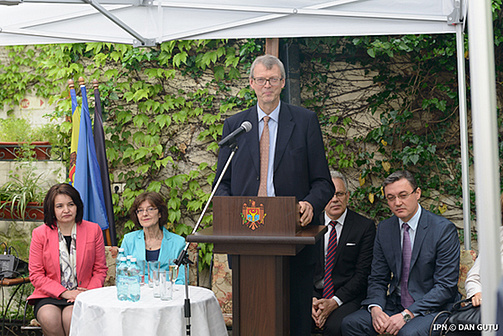In the opening of the exhibit, German Ambassador in Chisinau Matthias Meyer said that together with his colleagues, they worked for two years to mount this event. It’s a unique and very special exhibition that presents the special contribution of the German colonists to the country’s development. “The past and the present are combined here. The settling of the Germans is shown by objects that they used every day,” said the ambassador, underlining that the influence of the German personalities on Bessarabia at the end of the 19th century represents a fascinating chapter in the diverse history of Moldova.
Vice President of the German Bundestag Ulla Schmidt, who came to Chisinau on a working visit, said the liberalization of the visa regime and the signing of the Association Agreement with the EU are only several of the good sides of the path chosen by Moldova. “This exhibit means more than 200 years of the immigration of the Germans to Bessarabia. It can show much more things,” she stated.
Attending the event, Head of Parliament Igor Corman said the exhibition is a page in the common history of the two states that comes to nicely complement the excellent bilateral relations between Moldova and Germany. “When we have this bridge between our countries and when the cultural aspects complement our relationship, we only enjoy advantages and it is an additional sign that the future will also be common if we had a common past and have a common preset,” he said.
Coordinator of the exhibit, writer Uta Schmidt, who is a Doctor of History, said the visitors of the exhibit will be able to see a panorama of Marienfeld village of Cimislia district, where a part of the colonists settled. The exhibit reveals details about the life in the village, about agriculture and handicrafts that represented the economic basis of the life in German settlements, about the roles of the church and the school that deeply marked the German mentality. The exhibit also presents the work of former mayor of Chisinau Karl Schmidt (1877-1903).
The event involved the political representative of Tiraspol to the Transnistrian conflict settlement talks Nina Shtanski, who was invited by the German Embassy in Chisinau, as she said.‘German traces’ at exhibition in Chisinau
The Embassy of Germany opened an exhibition entitled “German traces in Moldova, 1814-2014. Tradition and modernization” at the National Museum of Arts of Moldova in Chisinau. It forms part of the activities held to celebrate the 200th anniversary of the settling of Germans in Bessarabia. The exhibit shows the life of the Germans at the end of the 19th century, including in villages, the agricultural activity and trade, IPN reports.
In the opening of the exhibit, German Ambassador in Chisinau Matthias Meyer said that together with his colleagues, they worked for two years to mount this event. It’s a unique and very special exhibition that presents the special contribution of the German colonists to the country’s development. “The past and the present are combined here. The settling of the Germans is shown by objects that they used every day,” said the ambassador, underlining that the influence of the German personalities on Bessarabia at the end of the 19th century represents a fascinating chapter in the diverse history of Moldova.
Vice President of the German Bundestag Ulla Schmidt, who came to Chisinau on a working visit, said the liberalization of the visa regime and the signing of the Association Agreement with the EU are only several of the good sides of the path chosen by Moldova. “This exhibit means more than 200 years of the immigration of the Germans to Bessarabia. It can show much more things,” she stated.
Attending the event, Head of Parliament Igor Corman said the exhibition is a page in the common history of the two states that comes to nicely complement the excellent bilateral relations between Moldova and Germany. “When we have this bridge between our countries and when the cultural aspects complement our relationship, we only enjoy advantages and it is an additional sign that the future will also be common if we had a common past and have a common preset,” he said.
Coordinator of the exhibit, writer Uta Schmidt, who is a Doctor of History, said the visitors of the exhibit will be able to see a panorama of Marienfeld village of Cimislia district, where a part of the colonists settled. The exhibit reveals details about the life in the village, about agriculture and handicrafts that represented the economic basis of the life in German settlements, about the roles of the church and the school that deeply marked the German mentality. The exhibit also presents the work of former mayor of Chisinau Karl Schmidt (1877-1903).
The event involved the political representative of Tiraspol to the Transnistrian conflict settlement talks Nina Shtanski, who was invited by the German Embassy in Chisinau, as she said.




